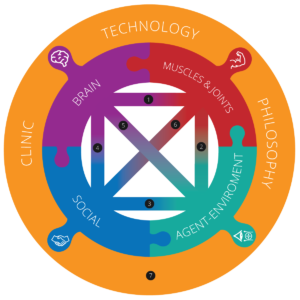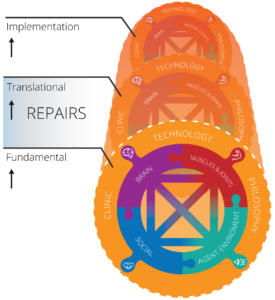Project Overview
REPAIRS aims to improve rehabilitation training of movement disorders and disabilities related to perception and action, by exploiting a systems perspective. From this perspective perception and action in everyday behaviour is considered to emerge from mutual, nonlinear interactions among its constituent elements. To fully exploit the systems approach, REPAIRS studies interactions among four levels of the perception-action cycle: brain level, muscles & joints level, agent-environment level and social level. The knowledge about these interactions is integrated with knowledge on translating fundamental knowledge to clinical applications generated in clinical, technological and philosophical domains.
In the ESR projects, REPAIRS first reveals novel insight on re-learning perception and action (in people without a movement disorder). To this end, the ESRs exploit Dynamic Systems Theory and Ecological Psychology to understand the interactions and relations among levels that make up the perception-action cycle. Next, this knowledge is integrated with knowledge of re-learning in clinical populations to develop a series of novel clinical practices. Each of these clinical practices will be applied to a different clinical populations.
Objectives
REPAIRS brings together European academic researchers on perception-action couplings from a systems perspective, with clinical and technological partners to mentor a new generation of scientists to drive a systems approach to re-learning perception-action couplings in the field of rehabilitation. Two main research objectives have been identified to answer the challenges in this field:
- Reveal integrated knowledge about multi-factorial, nonlinear interactive processes underlying learning perception-action couplings among the Brain, Muscles & Joints, Agent-Environment and Social levels.
- Develop knowledge on requirements for translating knowledge in rehabilitation practice from a systems perspective and apply this to advance that rehabilitation practice.
Systems perspective
Nonlinear cause-effect relations are omnipresent in mechanisms underlying movement disorders. For instance, an Anterior Cruciate Ligament (ACL) injury is not just dependent on the knee valgus during landing but also on co-occurrences of events spread out over time. That is, dorsiflexion range of motion in the ankle or training load modulate the effect of knee valgus during landing on ACL injury, revealing nonlinear interactions between factors affecting the ACL injury. Therefore, an effective rehabilitation practice should appreciate nonlinear interactions and complex relations among components underlying emergent behaviour.
Understanding the origins of a movement disorder also requires understanding non-linear interactions among levels of the perception-action cycle. For instance, an injury at the brain level (e.g. a stroke) affects structural relations between brain regions due to neuroplasticity processes. Moreover, prolonged inactivity of muscles caused by the insult alters muscle properties and muscle coordination patterns, affecting the ability to re-learn movements in rehabilitation training. In addition, the inability to perform certain actions substantially affects social interactions, which strongly affect brain activity also in regions not directly linked to the stroke. Therefore, REPAIRS studies the effects of a disorder from a complex interaction of levels distributed over the whole perception-action cycle.

Structure of REPAIRS
The figure on the right presents the approach of REPAIRS, showing the interaction and integration between four levels of the perception-action cycle: brain, muscles & joints, agent-environment and social. Between those levels research pillars are defined (see numbers in figure). ESR projects always involve at least two of these levels to study interactions from which learning in perception-action emerges. Pillar 7 forms a layer around these projects focussing on integrating the basic research findings in rehabilitation through developing requirements on translation from clinical, technological and philosophical perspectives. This programme structure ensures a focus on nonlinear interactions and provides for an interdisciplinary and intersectoral training.
Clinical populations
The following clinical populations will be the focus of study in REPAIRS:
- adults suffering from a stroke,
- people with a Anterior Cruciate Ligament (ACL) injury
- people with a knee endoprosthesis,
- people with a visual impairment,
- adults with schizophrenia,
- children and adults diagnosed with Autism Spectrum Disorder (ASD),
- children diagnosed with Developmental Coordination Disorder (DCD).
Approach
Restoring functional ability requires the re-learning of perception-action couplings. REPAIRS develops fundamental knowledge on the learning of perception-action couplings in people without a movement disorder or disability related to perception and action. This knowledge is then integrated with knowledge on learning in clinical populations to develop innovative rehabilitation practices. Hence, REPAIRS operates in the early stages of rehabilitation research at the transition from fundamental research to translational research, see the figure below.

Technology, conceptual analyses, data analyses using cutting-edge techniques, and philosophical analyses will be exploited in novel ways in the ESR projects. Experimental, observational and modelling studies will be performed at the behavioural and at the neural level applying technological innovations and using novel data analysis techniques.
Training
The training takes place through supervision of experts in the field, close interactions with other PhD students in the project, collaborative training projects, network wide training events and secondments in academic, clinical and industry settings, and local and network wide journal clubs. The training focuses on research and academic skills but also on transferrable skills, teamwork skills, leadership and entrepreneurial skills. The goal of the training is to provide PhDs with the skills that enable them to push the field of re-learning perception and action and the field of rehabilitation to the next level.